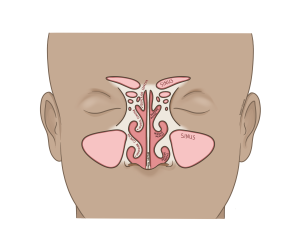49 Nasal Skull
What is the Nasal Skull?
Have you ever found that when you’re sick, it’s hard to breathe through your nose? Well, you can thank the mucosa lining of your nasal cavity for that.
The nasal cavity is a broad area of space in the skull behind the nose consisting of pockets of space called sinuses which allow inhaled air to be warmed. These sinuses are lined with mucus membranes which can become inflamed during upper respiratory tract infections, causing pain and pressure in this region.
The nasal cavity is separated primarily by a bony and cartilaginous divider called the nasal septum. The nasal septum aids primarily in directing airflow and supporting the structure of the nose.
In addition to the nasal septum, there are the nasal conchae, which are seashell-like structures lined with a mucous membrane. There are three nasal conchae on each side of the nasal cavity, creating three pockets of air known as the nasal meatuses. The curved shapes of the nasal conchae create turbulent airflow, increasing the contact between the air and the mucous membrane lining. The nasal conchae and meatuses help to modify the air we breathe, ensuring our upper respiratory tract remains properly conditioned.
Then, there are the openings at the back of your nose known as nasal meatuses which provide drainage routes for nasal mucus and also tears from your eyes. This is why when you’re crying you may get sniffles as your sinuses become blocked with tears.

Figure 104 The nasal skull, sinuses, conchae, and meatuses

